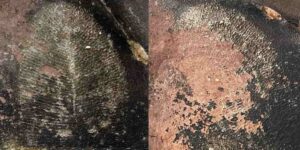
In 2020, amid the first pandemic lockdowns, a scientific conference scheduled to take place in India never happened.
But a group of geologists who were already on site decided to make the most of their time and visited the Bhimbetka Rock Shelters, a series of caves with ancient cave art near Bhopal, India. There, they spotted the fossil of Dickinsonia¸ a flat, elongated and primitive animal from before complex animals evolved. It marked the first-ever discovery of Dickinsonia in India.
The animal lived 550 million years ago, and the find seemed to settle once and for all the surprisingly controversial age of the rocks making up much of the Indian subcontinent. The find attracted the attention of The New York Times, The Weather Channel and the scientific journal Nature as well as many Indian newspapers.
Only, it turns out, the “fossil” was a case of mistaken identity. The true culprit? Bees.
University of Florida researchers traveled to the site last year and discovered the object had seemingly decayed significantly — quite unusual for a fossil. What’s more, giant bee’s nests populate the site, and the mark spotted by the scientists in 2020 closely resembled the remains of these large hives.
“As soon as I looked at it, I thought something’s not right here,” said Joseph Meert, a UF professor of geology and expert on the geology of the area. “The fossil was peeling off the rock.”
The erstwhile fossil was also lying nearly vertical along the walls of the caves, which didn’t make sense. Instead, Meert says, fossils in this area should only be visible flat on the floor or ceiling of the cave structures.
Meert collaborated on the investigation with his graduate students Samuel Kwafo and Ananya Singha and University of Rajasthan professor Manoj Pandit. They documented the rapid decay of the object and photographed similar remains from nearby beehives. The team published their findings of the mistaken identity Jan. 19 in the journal Gondwana Research, which previously published the report of the serendipitous Dickinsonia fossil find.
Gregory Retallack, professor emeritus at the University of Oregon and lead author of the original paper, says he and his co-authors agree with Meert’s findings that the object is really just a beehive. They are submitting a comment in support of the new paper to the journal.
This kind of self-correction is a bedrock principle of the scientific method. But the reality is that admitting errors is hard for scientists to do, and it doesn’t happen often.
“It is rare but essential for scientists to confess mistakes when new evidence is discovered,” Retallack said in an email.
Correcting the fossil record puts the age of the rocks back into contention. Because the rock formation doesn’t have any fossils from a known time period, dating it can be difficult.
Meert says the evidence continues to point to the rocks being closer to one billion years old. His team has used the radioactive decay of tiny crystals called zircons to date the rocks to that time period. And the magnetic signature of the rocks, which captures information about the Earth’s magnetic field when the rocks formed, closely matches the signatures of formations confidently dated to a billion years ago.
Other scientists have reported findings supporting a younger age. The time period is essential to understand because of its implications for the evolution of life in the area and how the Indian subcontinent formed.
“You might say, ‘Okay, well what’s the big deal if they are 550 million or a billion years old?’ Well, there are lots of implications,” Meert said. “One has to do with the paleogeography at the time, what was happening to continents, where the continents were located, how they were assembled. And it was a period when life was going through a major change, from very simple fossils to more complex fossils.”
“So trying to figure out the paleogeography at the time is very, very important. And in order to figure out the paleogeography, we have to know the age of the rocks,” he said.
Reference:
Joseph G. Meert, Manoj K. Pandit, Samuel Kwafo, Ananya Singha. Stinging News: ‘Dickinsonia’ discovered in the Upper Vindhyan of India not worth the buzz. Gondwana Research, 2023; 117: 1 DOI: 10.1016/j.gr.2023.01.003
Note: The above post is reprinted from materials provided by University of Florida. Original written by Eric Hamilton.










